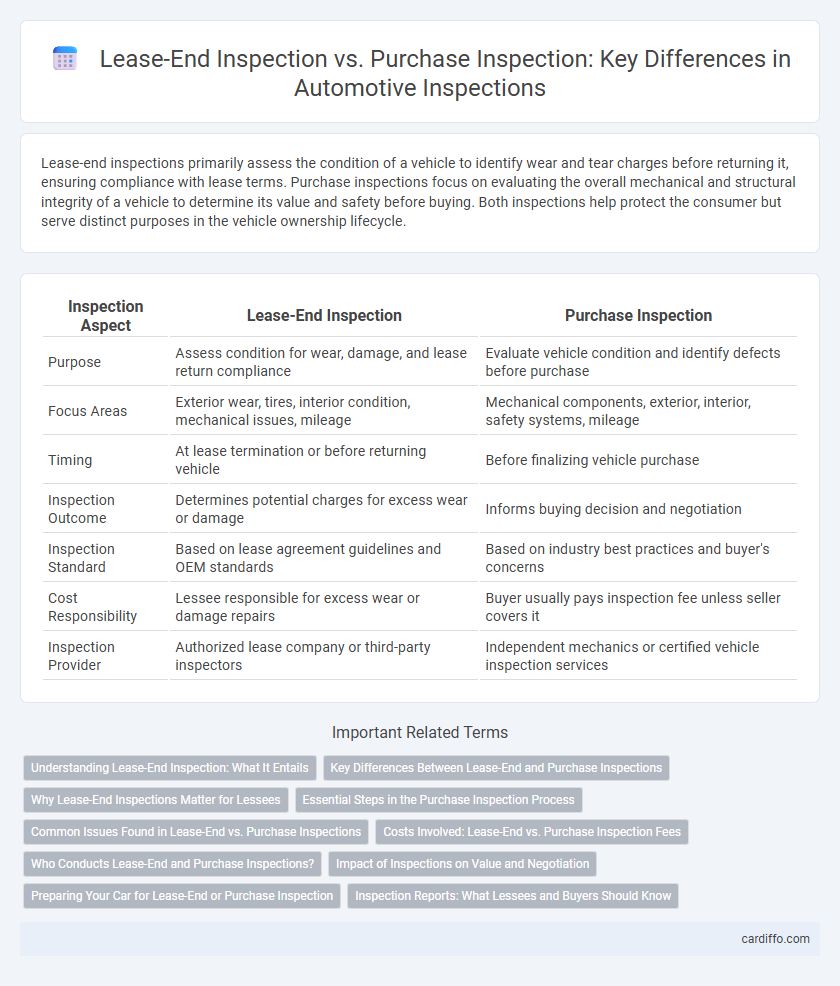Lease-end inspections primarily assess the condition of a vehicle to identify wear and tear charges before returning it, ensuring compliance with lease terms. Purchase inspections focus on evaluating the overall mechanical and structural integrity of a vehicle to determine its value and safety before buying. Both inspections help protect the consumer but serve distinct purposes in the vehicle ownership lifecycle.
Table of Comparison
| Inspection Aspect | Lease-End Inspection | Purchase Inspection |
|---|---|---|
| Purpose | Assess condition for wear, damage, and lease return compliance | Evaluate vehicle condition and identify defects before purchase |
| Focus Areas | Exterior wear, tires, interior condition, mechanical issues, mileage | Mechanical components, exterior, interior, safety systems, mileage |
| Timing | At lease termination or before returning vehicle | Before finalizing vehicle purchase |
| Inspection Outcome | Determines potential charges for excess wear or damage | Informs buying decision and negotiation |
| Inspection Standard | Based on lease agreement guidelines and OEM standards | Based on industry best practices and buyer's concerns |
| Cost Responsibility | Lessee responsible for excess wear or damage repairs | Buyer usually pays inspection fee unless seller covers it |
| Inspection Provider | Authorized lease company or third-party inspectors | Independent mechanics or certified vehicle inspection services |
Understanding Lease-End Inspection: What It Entails
Lease-end inspection involves assessing a leased vehicle's condition against predefined wear and tear standards, identifying any damages or excessive mileage that may incur additional charges. This process ensures lessees comply with lease agreements and decide on repair or purchase options before returning the vehicle. Understanding lease-end inspection criteria helps avoid unexpected fees and facilitates informed decisions regarding vehicle disposition.
Key Differences Between Lease-End and Purchase Inspections
Lease-end inspections primarily assess wear and tear according to leasing agreements, identifying damages that may incur additional fees, while purchase inspections evaluate the overall condition and potential issues of a vehicle before ownership transfer. Lease-end inspections focus on ensuring the vehicle meets return standards, emphasizing cosmetic damage, tire condition, and maintenance records. Purchase inspections provide a comprehensive mechanical and safety assessment, helping buyers negotiate price or avoid future repair costs.
Why Lease-End Inspections Matter for Lessees
Lease-end inspections are crucial for lessees to identify potential damages or excessive wear and tear before returning a leased vehicle, preventing unexpected repair costs and disputes with the leasing company. These inspections help lessees understand and address lease agreement terms, ensuring compliance and maximizing security deposit refunds. Early detection of issues supports informed decision-making about lease extensions or vehicle replacement.
Essential Steps in the Purchase Inspection Process
Purchase inspections require a thorough evaluation of the property's structural integrity, major systems, and potential safety hazards to ensure buyer confidence. Essential steps include a detailed walkthrough, verifying electrical, plumbing, and HVAC functionality, and assessing the roof, foundation, and insulation conditions. Documenting findings with a comprehensive report aids in negotiating repairs and finalizing the purchase agreement effectively.
Common Issues Found in Lease-End vs. Purchase Inspections
Lease-end inspections commonly reveal wear-and-tear issues such as minor scratches, tire wear, and interior stains, while purchase inspections frequently identify more significant problems like engine faults, brake system wear, and suspension damage. Lease-end inspections focus on ensuring the vehicle meets return condition standards, highlighting cosmetic and maintenance neglect, whereas purchase inspections emphasize safety and long-term reliability, detecting hidden defects and mechanical failures. Understanding these distinctions helps buyers and lessees address specific repair needs and negotiate costs effectively.
Costs Involved: Lease-End vs. Purchase Inspection Fees
Lease-end inspections typically involve lower fees, often ranging from $50 to $150, as they assess vehicle condition relative to lease agreements and wear limits. Purchase inspections can cost between $100 and $300, reflecting a more comprehensive evaluation to identify existing or potential issues before buying. Understanding these cost differences helps consumers budget appropriately for inspection services tailored to either lease returns or vehicle purchases.
Who Conducts Lease-End and Purchase Inspections?
Lease-end inspections are typically conducted by the leasing company's authorized agents or third-party inspectors to assess the vehicle's condition against the lease agreement standards. Purchase inspections are performed by prospective buyers, independent mechanics, or dealership technicians to evaluate the vehicle's mechanical health and overall value before completing the sale. Both inspections require expertise but differ in purpose: lease-end inspections focus on wear and damage, while purchase inspections prioritize mechanical reliability and repair needs.
Impact of Inspections on Value and Negotiation
Lease-end inspections primarily assess the condition of a rented property to identify damages beyond normal wear and tear, influencing security deposit returns and potential lease renewal terms. Purchase inspections evaluate structural integrity, safety, and required repairs, directly impacting the property's market value and providing leverage for price negotiations. Thorough inspections can uncover issues that affect financial decisions, enabling tenants or buyers to negotiate repairs, credits, or price adjustments effectively.
Preparing Your Car for Lease-End or Purchase Inspection
Preparing your car for a lease-end or purchase inspection requires a thorough cleaning and addressing any minor repairs to avoid penalties or negotiation setbacks. Ensure all scheduled maintenance is up-to-date, including oil changes and tire rotations, to demonstrate proper vehicle care. Documenting the car's condition with photos and service records supports transparency and can expedite the inspection process.
Inspection Reports: What Lessees and Buyers Should Know
Inspection reports for lease-end inspections emphasize assessing vehicle condition against initial agreements, detailing wear and tear to determine potential charges for lessees. Purchase inspection reports provide comprehensive evaluations of mechanical components, safety features, and overall vehicle integrity to inform buyers before acquisition. Both reports play a critical role in protecting financial interests by documenting current vehicle states with factual, objective findings.
Lease-end inspection vs purchase inspection Infographic

 cardiffo.com
cardiffo.com